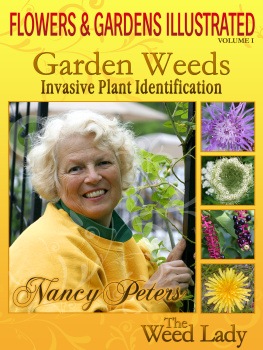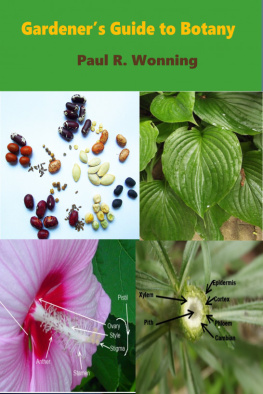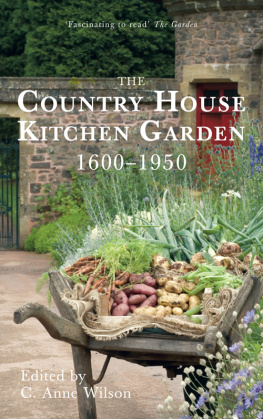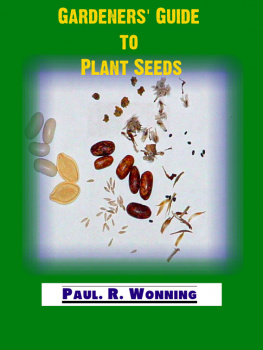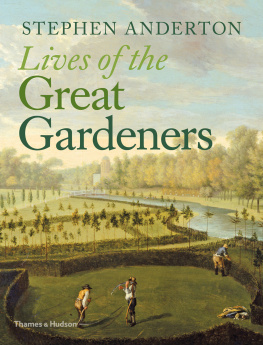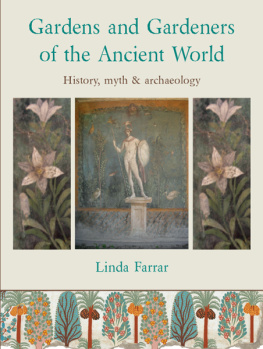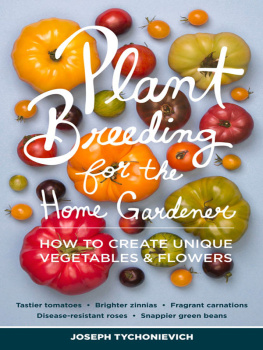THE HEAD GARDENERS

Dr. Toby Musgrave is a horticulturist and garden historian, and author of a number of books including the best-selling The Plant Hunters, An Empire of Plants, The Seven Deadly Sins of Gardening, Courtyard Gardens and Cottage Gardens. Presenter of the DVD Your First Garden Made Easy, Toby designs gardens around the world and lectures widely on garden history and garden design. For more information visit www.TobyMusgrave.com
THE HEAD
GARDENERS
Forgotten Heroes of Horticulture

TOBY MUSGRAVE
Hortis qui praesunt, vos nunc priscosque ministros rite salutamus: floreat omne genus.
DR ARMAND DANGOUR 2007

to Vibeke
for everything
my love and thanks

First published in 2007
by Aurum Press Ltd
7477 White Lion Street
London N1 9PF
www.aurumpress.co.uk
This eBook edition first published in 2014 by Aurum Press Ltd
Copyright 2007, 2014 Toby Musgrave
The moral right of Toby Musgrave to be identified as the author of this work has been asserted by him in accordance with the Copyright, Designs and Patents Act 1988.
All rights reserved
This eBook is copyright material and must not be copied, reproduced, transferred, distributed, leased, licensed or publicly performed or used in any way except as specifically permitted in writing by the publishers, as allowed under the terms and conditions under which it was purchased or as strictly permitted by applicable copyright law. Any unauthorised distribution or use of this text may be a direct infringement of the authors and publishers rights, and those responsible may be liable in law accordingly.
A catalogue record for this book is available from the British Library.
eBook conversion by Quarto Publishing Group USA
Digital edition: 978-1-78131-115-8
Softcover edition: 978-1-84513-411-2
CONTENTS



ACKNOWLEDGEMENTS

I am grateful for the permission of Her Majesty Queen Elizabeth II to make use of the material from the Royal Archives at Windsor Castle.
My thanks to all who have helped in the production of this tome. Especially to Dr Armand DAngour for taking the time and interest to compose such an appropriate elegiac couplet, Chris Jones for her hospitality and conviviality, Dr Brent Elliott and the staff of the Lindley Library, the staff of the Rare Books Room at the University of Cambridge Library, and Penrhyn Castle, National Trust for kind permission to reproduce the oral archive of Norman Thomas. Thanks also to Sarah Dalkin and all at Aurum Press. Of course to Vibeke and Tasso. And last, but not least, to all head gardeners past and present who have made and continue to make gardens such a beautiful and pleasurable part of life.
INTRODUCTION

Adam could be called the first head gardener, for the practice of making gardens both as a form of art and for the production of edible crops is as old as civilisation itself. How far back gardening can be traced in England is, however, a matter of conjecture. Certainly the Romans brought to these shores both gardening skills and new plants, including varieties of rose, the vine and the sweet chestnut (Castanea sativa). The craft of horticulture was subsequently preserved behind the walls of monastic establishments during the Dark Ages before later invaders, the Normans, brought more new plants and more new ideas. A glance through any book on the subject of British garden history reveals that as successive centuries passed, and garden fashions came and went, so hundreds of great gardens were made by Lord this, Earl that, or Duke the other. These wealthy noblemen, and later, the socially aspirant nouveaux riches certainly footed the bills, but the physical creation and practical management of grand ornamental grounds and bounteous kitchen gardens required a large labour force overseen by a skilled and expert head gardener.
CHANGING ROLES OF THE GARDENER
It is the Pipe Rolls (or royal accounts) from the reigns of Henry III, and subsequently Edward I, that contain the first named English gardener one Edmund the Gardener, who received 2/ pence per day for his work at Windsor Castle (Berkshire) between 1256 and 1277. Edmunds epithet gives his profession but tells little of what he actually did; indeed for several hundred years after the Norman Conquest, the word gardener was widely used as a general term. Before 1606 and the Royal Charter that established the Company of Gardeners, a gardener could be anyone of various skills and often diverse social standing,
In the following three centuries, however, the horticulture industry evolved, diversified and became more sophisticated; so that by the turn of the nineteenth century there were demarcated but inter-related specialisms. The market gardener grew edible crops for market, while the landscape gardener designed gardens. Orchardmen produced and sold fruit trees, seedsmen sold seed, and florists raised and sold new varieties of a limited range of bulbs and fibrous-rooted plants, which became known as Florists Flowers. Nurserymen supplied a wider range of ornamental plants, be they run of the mill varieties or more sought-after items such as large specimens or rare plants from abroad. And the master or head gardener was a man charged with the responsibility of managing, maintaining and developing both the ornamental and productive gardens associated with a large country house estate.
However, one aspect of the head gardeners story that changes little down the centuries is the paucity of information about the men themselves. Not surprisingly, the closer we come to the modern day, the more information was generated and has survived. But for the largest part of the past millennium or so, the head gardener remains an unsung and elusive hero his name and something of his works may have survived, but little about the man himself.
What is a matter of record is that the head gardener emerged as a man of influence within the spheres of horticulture and botany during the seventeenth and, more notably, the eighteenth century. Certain head gardeners did become famous but often for another reason: in the eighteenth century, for example, Capability Brown as a landscape designer, Philip Miller an author, and James Gordon a nurseryman. But it was in the nineteenth century that the head gardeners star rose to its zenith, a position it held until the outbreak of the First World War. The stereotype of a head gardener of this period is a ferocious-looking, conspicuously bewhiskered chap, sporting a bowler hat, waistcoat and long apron; his fearsome demeanour consistent with his position as autonomous ruler of a large domain who terrorised his staff and employer alike. The engravings and, later, the photographs, of head gardeners of this time do nothing to belie this myth; nor does the behaviour of some notorious miscreants. In spite of their formidable appearance, however, the vast majority of head gardeners were honest men who worked exceedingly hard for a poor wage. Thus another truism that has remained constant down the centuries is that head gardeners do not so much have a job as a vocation a vocation which is undertaken for the love of the work and certainly not for the financial reward! The names of many of the nineteenth centurys head gardeners are a matter of record, but with the possible exception of Sir Joseph Paxton of Chatsworth (Derbyshire) have been forgotten. In many instances, their gardens are still extant, albeit shadows of their former glories Battersea Park (London), Belvoir (Leicestershire), Bicton Park (Devon), Cliveden (Buckinghamshire), Elvaston Castle (Derbyshire) and Shrubland Park (Suffolk) to name but half-a-dozen. But even though head gardeners of some of the centurys finest gardens were stars within their gardening world, who today remembers John Gibson, William Ingram, James Barnes, John Fleming, William Barron and Donald Beaton, or what they achieved?



